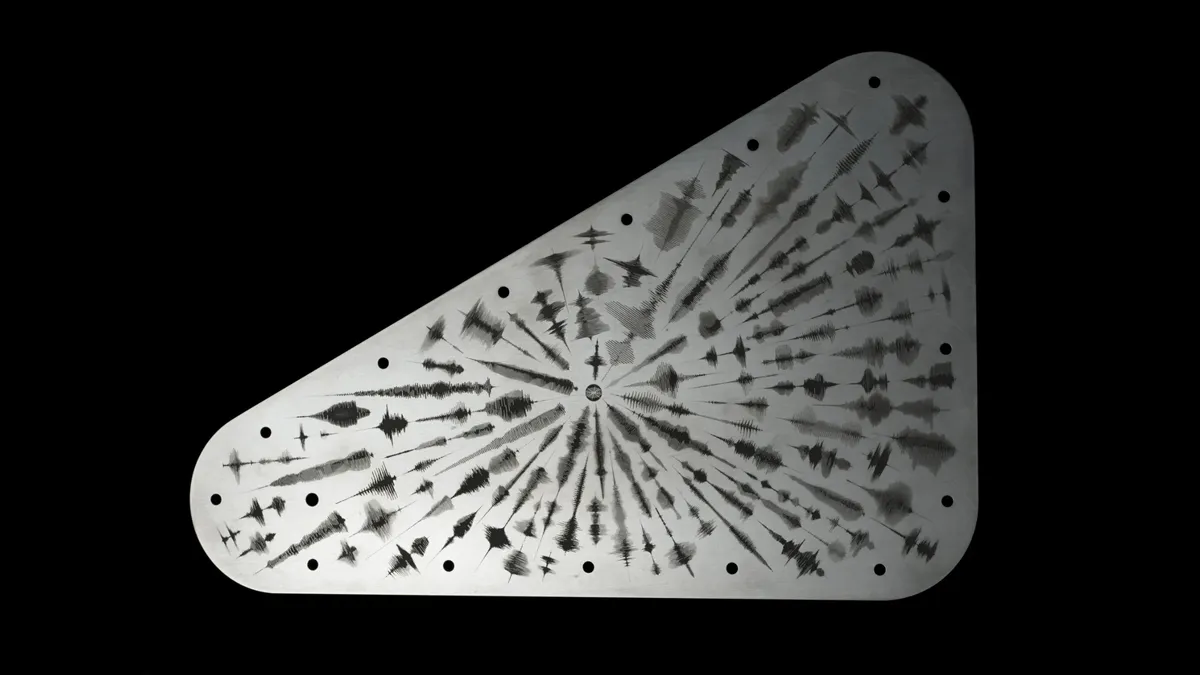Key Takeaways:
- NASA’s Clipper spacecraft mission to Europa integrates a human touch, featuring a cryptic message from millions of participants worldwide.
- Over 2.6 million names etched onto a dime-sized silicon microchip will journey aboard the spacecraft, alongside a handwritten poem by U.S. Poet Laureate Ada Limón.
- The commemorative plaque, adorned with symbolism highlighting Earth’s connection to Europa, serves as a symbolic gesture rather than a direct communication with potential extraterrestrial life.
- The intricate design of the plaque, incorporating waveforms representing the word “water” in various languages, underscores the mission’s emphasis on interconnectedness and exploration.
- Despite recent findings suggesting Europa’s potential lack of oxygen, the Europa Clipper mission remains pivotal in unraveling the mysteries of this enigmatic moon and its potential for harboring life.

Amidst the cosmic expanse, from the lyrical verses of a distinguished U.S. Poet Laureate to the inscribed multitude of appellations, the forthcoming odyssey of NASA’s Clipper spacecraft toward Europa shall be adorned with a distinctly human imprint.
Embarking on its celestial voyage to Jupiter’s frigid aqueous satellite, Europa, NASA has unveiled a cryptic missive imbued with humanity, poised to accompany its latest mission.
In the annals of 2023, the spacefaring agency initiated a venture christened “Message in a Bottle,” summoning forth legions from the populace to etch their signatures onto a missive destined for traversal across the solar system aboard the Europa Clipper spacecraft. The auspicious launch is slated to grace the heavens in October of 2024, marking a pivotal stride in an expedition aimed at delving into the potential habitability concealed beneath Europa’s icy veneer.
In a communiqué disseminated on March 8th, NASA has now divulged the conduit through which these monikers shall traverse the void. Exceeding a tally of 2.6 million, names have been meticulously etched onto a diminutive silicon microchip, the size of a dime, by adept artisans at the Microdevices Laboratory ensconced within NASA’s Jet Propulsion Laboratory. This minuscule artifact shall be affixed to a commemorative plaque, bedecked with a handwritten rendition of the poem “In Praise of Mystery: A Poem for Europa” penned by U.S. Poet Laureate Ada Limón, among an array of other embellishments.
Comprising dimensions of approximately 7 by 11 inches and crafted from the alloy tantalum, the plaque shall be adorned on both surfaces with imagery that “illuminates Earth’s nexus with Europa,” as delineated by NASA in the proclamation. Given the likelihood of any potential life on Europa being microbial in nature, the commemorative plaque serves more as a symbolic overture than a literal communiqué to extraterrestrial entities.
“The composition and aesthetic of Europa Clipper’s vault plate resonate with profound significance,” remarked Lori Glaze, overseeing the Planetary Science Division at NASA.
“The plaque encapsulates the zenith of human achievement across the cosmos — encompassing science, technology, education, art, and mathematics. The overarching theme of interconnectedness through water, a fundamental requisite for all known life forms, aptly underscores Earth’s kinship with this enigmatic aqua world we are poised to explore.”
The intricate detailing adorning the plaque pays homage to the scientific endeavor at hand and the intertwining rapport between Earth and Europa. Notably, the outward-facing facet features waveforms, graphical representations of auditory vibrations derived from utterances of the term “water” in 103 diverse languages. Conversely, the inward-facing surface incorporates visual motifs pertaining to the electromagnetic frequencies conducive to prospective interstellar discourse.

“We have imbued this plaque design with meticulous contemplation and inspiration, mirroring the depth of thought invested in the overarching mission,” articulated Robert Pappalardo, serving as a principal scientist at NASA’s Jet Propulsion Laboratory. “This odyssey has spanned decades, and we eagerly anticipate the revelations Europa Clipper shall unveil upon this aqueous realm.”
Following a prodigious traverse spanning 1.8 billion miles through the cosmos, Clipper is anticipated to commence orbit around Jupiter by the year 2030. Subsequently, it is slated to execute approximately 49 close proximities to Europa. Scientists aspire to harness the mission to procure insights into the subterranean recesses of Europa’s ocean, teeming with a reservoir twofold the magnitude of all Earthly seas, alongside gleanings from the moon’s glaciated crust, tenuous atmosphere, and spatial milieu.
Long regarded as a beacon in the quest for extraterrestrial life, Europa has recently been cast under scrutiny by findings from NASA’s Juno mission, hinting at a potential dearth of oxygen necessary to sustain life, thereby tempering optimism. The forthcoming observations undertaken by Europa Clipper hold promise in resolving this enigma.


